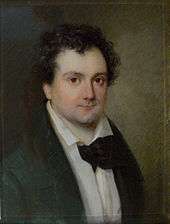Johann Nestroy

Johann Nepomuk Eduard Ambrosius Nestroy (7 December 1801 – 25 May 1862) was a singer, actor and playwright in the popular Austrian tradition of the Biedermeier period and its immediate aftermath. Dubbed the "Austrian Shakespeare", in style he is more comparable to Molière.

Career
Nestroy was born in Vienna, where he was a law student from 1817 to 1822, before abandoning his studies to become a singer. He joined the Theater am Kärntnertor, beginning with Sarastro in The Magic Flute on 24 August 1822. After a year of singing in Vienna, he went to Amsterdam where he appeared in baritone roles for two years at the local German Theatre. From 1825 to 1831 he accepted engagements to sing and act in Brünn, Graz, Pressburg, Klagenfurt, Vienna and Lemberg. He then returned to his native Vienna and started to write and continued to perform.
Nestroy's career as a playwright was an immediate success: his 1833 play Der böse Geist Lumpazivagabundus was a major hit. He soon became a leading figure in Austrian culture and society. Nestroy succeeded Ferdinand Raimund as the leading actor-dramatist on the Volkstheater, the Viennese commercial stage or 'people's theatre'.
Whereas Raimund concentrated on romantic and magical fantasies, Nestroy used comedy for parody and criticism. Working at the time of conservative minister Klemens von Metternich, he had to carefully draft his plays to skirt the strict censorship in place. His interest in word play was legendary, and his characters often mixed Viennese German with less-than-successful attempts at more "educated" speech. Music held an important role in his work, with songs elaborating the theme or helping on with the plot.

Nestroy wrote nearly eighty comedies between the 1830s and the 1850s. Among the most important were Der böse Geist Lumpazivagabundus, Liebesgeschichten und Heiratssachen, Der Talisman (made into the 1939 musical comedy Titus macht Karriere by Edmund Nick), Einen Jux will er sich machen (translated as On the Razzle by Tom Stoppard in 1981) and Der Zerrissene, all of which were marked by social criticism and biting satire. He died in Graz, Austria.
Works
Nestroy remained a singer all his life, and virtually all his plays include music. He worked closely with a relatively small number of composers: Adolf Müller, who set 41 of Nestroy's texts between 1832 and 1847, Michael Hebenstreit who set 10 works from 1843 to 1850, Karl Binder who set seven from 1851 to 1859, as well as Anton M. Storch, Franz Roser, Carl Franz Stenzel, and Andreas Skutta.
Most of his works were designated as some form of Posse or farce, and of these the majority were Possen mit Gesang (i.e. 'with singing'). He also produced a number of parodies, both of operas (including Cendrillion, La Cenerentola, Lohengrin, Martha, Robert le diable, Tannhäuser and Zampa) and dramas (including von Holteis Lorbeerbaum und Bettelstab and Raupach's Robert der Teufel). In addition he wrote four Quodlibets, two Burlesken, a Travestie and finally an Operette using music by Jacques Offenbach.
His early works were performed in Graz and Pressburg, then from 1832 to 1846 he worked exclusively at the Theater an der Wien where 45 of his plays were premiered. After two productions at the Theater in der Leopoldstadt, he then moved to the Carltheater from 1847 to 1859 where another 20 were performed.
Nestroy's legacy

About half of Nestroy's works have been revived by the modern German-speaking theatres and many are part and parcel of today's Viennese repertoire. However, few have ever been translated into English. Only one, Einen Jux will er sich machen, has become well known to English-speaking theatregoers. Interestingly, it has become a classic more than once. It was first adapted as Thornton Wilder's The Matchmaker (which later became the musical Hello, Dolly!) and later achieved success as the comic masterpiece On the Razzle, which was translated by Stephen Plaice and adapted by Tom Stoppard.
Nestroy has a square—Nestroyplatz—named after him in Vienna, as well as a station on Line 1 of the Vienna U-Bahn, which opened in 1979. When the Reichsbrücke had to be rebuilt after its collapse in 1976, the tender was won by a consortium named Project Johann Nestroy. The official name of the newly built bridge is probably Johann Nestroy Brücke,[1] but that name doesn't seem to have any currency.
The most important German speaking theatre award is named after Nestroy. The "Nestroy Award" is an annual award for German theatre with Oscar-like categories. Its ceremony is held in Vienna and broadcast live on national television.
The Austrian illustrator and painter Reinhard Trinkler adapted Nestroy's famous play Der Talisman for a graphic novel of the same name.[2]
References
- Branscombe, Peter (1992), 'Nestroy, Johann Nepomuk' in The New Grove Dictionary of Opera, ed. Stanley Sadie (London) ISBN 0-333-73432-7
- ↑ "Auch Reichsbrücke brach am 1. August", Der Standard (5 August 2007) (German)
"25 Jahre Reichsbrücke", ORF (9 July 2005) (German)
"Wiener Reichsbrücke: Einsturz jährt sich zum 30. Mal", Kleine Zeitung (2 August 2007) (German) - ↑ Der Talisman - Graphic Novel, homepage of the publisher Edition Steinbauer (German)
External links
| Wikimedia Commons has media related to Johann Nestroy. |
- Johann Nestroy at the Internet Movie Database
- Internationales Nestroy Zentrum (in German)
- Nestroy information from aeiou.at (in German)
|